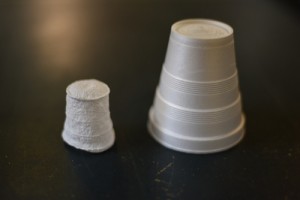By Eric Collins, University of Alaska Fairbanks
Have you ever held your breath and tried to dive to the bottom of a swimming pool? If you have, you might have noticed that you have to ‘pop’ your ears at some point because pressure builds up the further down you go. You might notice that the same thing happens when you are flying in a plane and start descending into the landing. These effects are caused by the same thing: changes in pressure. But you’ll notice that it takes a lot bigger difference in altitude to cause this effect in the air than under the water. This is because water is much denser than air, so that for an equivalent area, say 1 square foot, 33 feet of water have the same weight as the entire column of atmosphere, nearly 60 miles up to space.
This fact is important for ocean life because the average depth of the ocean is over 12,000 feet, which equals nearly 400 atmosphere-equivalents of pressure! Marine life forms, from bacteria to whales, have evolved adaptations to deal with these changes in pressure. Fortunately for us, styrofoam cups have not.
Table 1. Adaptations to life in the deep sea
| Thing | Adaptation |
| whale | compress their lungs when they dive to avoid lung collapse |
| deep sea fish | lack gas-filled swim bladders |
| deep sea bacterium | produce special enzymes that work best at high pressure |
| styrofoam cup | none |
Styrofoam cups, like marine organisms, are composed of cells. In the case of biology, cells are water-filled sacs with enzymes, sugars, fats, and other organic chemicals that make up life. The cells of styrofoam cups are filled with air. This is a useful property because air is a very effective insulator, which means that it transfers heat poorly, which is convenient if you want to hold boiling water (or coffee) in your hand.
Water, which is the main component of biological cells, is nearly incompressible — if you squeeze it under high pressure, it doesn’t really get smaller. Air, on the other hand, is easily compressible, so that when you squeeze it, it gets a lot smaller. Probably you have several air compressors in your immediate vicinity — cars and refrigerators both have them, for example.
So, the question is: what happens to a styrofoam cup when it is taken out of its natural habitat and placed into the deep sea? To find out, we exposed dozens of cups to a pressure of 380 atmospheres by lowering them to the bottom of the Pacific Ocean. Take a look at what we found!
Figure 1. Before.
Figure 2. After.
Figure 3. Comparison.
Posted by Eric



